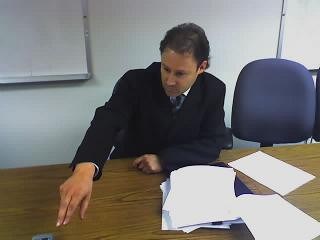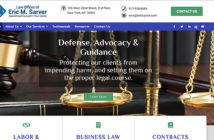Networking is his number one source of new clients, with other attorneys, including competitors, referring much of that new business.
In his 17 years of solo practice, attorney Charles Krugel has successfully used a variety of marketing tools to acquire new clients, generate repeat business, and offer expanded and or additional services to existing clientele.
Chicago-based Krugel specializes in human resources, labor and employment law and counseling on behalf of business.
“I usually work a 70 hour week and spend from 18 to 25 hours a week on marketing,” Krugel says. His marketing expenses run, on average, at roughly $2,000 annually.
Networking: Most Effective Marketing Tool
“My most effective marketing tool is networking,” Krugel says.
“In my opinion, networking is about creating and fostering relationships with people from all walks of life and is a powerful marketing method.”
“Networking …also includes developing relationships with current clients and other attorneys, including competitors.”
Although it may be unusual for competing attorneys to refer work to one another, Krugel often refers business to other attorneys and in turn gets referrals from them.
“I get a lot of referrals from competitors and try to reciprocate on [legal]matters that I may not handle,” he says. “These would include large, multi-jurisdictional class action matters and immigration.”
Public Speaking Generates Business
Krugel is also a frequent public speaker on the legal issues of his specialty and considers this as another marketing tool.

“This is because I’m in front of a large number of people …to discuss issues with me, and who’ll see me in action and remember the value I provide in these presentations,” he says.
Krugel’s public speaking engagements are hosted by organizations that want an experienced attorney to discuss labor and employment law, and subjects related to human resources and personnel, such as harassment, workplace issues that have become increasingly frequent and complex in recent years.
Among the organizations that Krugel has addressed, are various non-profits, business associations, municipal chambers of commerce, and government agencies such as The Illinois Department of Employment Security. Speaking before these groups frequently results in new client business.
A Yearly Series for the City of Chicago
An especially productive speaking venue in terms of client generation for Krugel has been the City of Chicago Department of Business and Consumer Affairs.
“Since 2010 I’ve given an annual series of four presentations, sponsored by the City of Chicago, to business owners and operators on employment and human resources legal subjects, including the MeToo movement and sexual harassment; uses and abuses of social media and employee classification–independent contractor [1099] vs. employee [W2].”
“My presentations are given in the question and answer format,” Krugel says.
“It’s always an open, roundtable discussion. I hate lecturing. It’s boring and tedious. I try very hard to engage attendees. Moreover, answering questions on the fly is a way for me to show off.”
Krugel’s presentations run from one to three hours. He also often serves as a panel member of discussion groups with three to five other attorneys.
Talking to Goldman Sachs, LexisNexis, Thomson Reuters
Owing to the success of these presentations, city of Chicago officials have recommended Krugel to other organizations, including corporate entities, the most prominent of which is Goldman Sachs and its 10,000 Small Businesses program to help entrepreneurs create jobs and economic opportunity.
Other corporations Krugel has addressed includes LexisNexis, Thomson Reuters, Paychex and Financial Poise, all of which have generated paying clients.
“Once your name is out there on the public speaking circuit, opportunities start coming your way,” Krugel says.
Not all of Krugel’s networking initiatives have been effective. What Krugel describes as ‘pay-for-play’ networking – has not been productive for him.
These are, “General networking groups that operate on a primarily ‘pay-for-play’ model in which each member [pays a fee to join the group]and is bound to one-another to provide referrals,” he explains.
“These are transactionally-focused networking groups in that members pay fees, and they’re overly exclusive in one way or another; not in any illegal or immoral way but they may be open to only one member of a practice or professional area. Generally, my success with those types of groups has been poor.”
But not all networking has to involve transactional relationships, nor does it have to be that way, according to Krugel.
Trading Ideas with Attorneys and Professionals
“I find that a lot of valuable networking occurs when I’m talking with other attorneys and professionals, even competitors, and bouncing ideas off one-another. These are more informal discussions and are often beneficial for multiple reasons, such as discussing legal issues, client relations and marketing.”
“I enjoy having broad business-related discussions with professionals and don’t enjoy focusing on what we can or can’t do for each other in transactions. Although it’s great to help one-another out on a transactional level, that doesn’t mean that a transactionally-based business relationship is always the most beneficial type of business relationship. The transactional model really doesn’t work for me.”
Besides networking, social media is another component of Krugel’s marketing ongoing program.
“LinkedIn and my blog and website are my main social media marketing tools,” Krugel says.
“Relative to LinkedIn, about 10 years ago, I started my own LinkedIn Group called Charles Krugel’s Labor and Employment Law and Human Resources Practices Group. It has 3,687 members from all over the world, and from different corporations, law firms and other professional groups. It’s an open discussion forum and seems to have significantly raised my online profile.”
LinkedIn: Easy to Use, Few Bugs
“I find that LinkedIn is a great way to meet other professionals and prospective clients. It’s relatively easy to use and has few bugs.”
Another of his most effective marketing tools, according to Krugel, is his website and blog.
“My website, which is a customized WordPress blog, is another key part of my marketing program,” he says.
“I’ve had a website for about 17 years now. My current website is about five years old. It provides me a simple way to post media interviews, notices about presentations and practice-related original content. Also, it’s easy to share content between my blog and LinkedIn.”
What’s on the Website

The website presents a comprehensive profile of Krugel, his practice and the services it offers, and an extensive list of client testimonials, a list of his awards, presentations, seminars, and citations of articles about him in various publications. An essay in the About section of the site entitled “What Is Human Resources and Why It Matters” explains his specialty.
Krugel wrote about 90 percent of his website’s content. The remainder of the content was written by colleagues or freelance writers.
A color photograph of Krugel set against a Chicago cityscape helps personalize him and his message.
“My message is that I’m an accessible, personable and outstanding labor and employment lawyer and human resources counselor,” he says.
“Everything I post is about my practice and related activities, including presentations I’m giving, media interviews and my community and charitable activities. I don’t get too personal or diverge much from my practice.”
Krugel says he realized the value of a blog early in his practice. He posts a blog message at least once every two weeks.
Krugel’s Blog: Easy to Update and Manage
“A blog is easier to update and manage, and it works as well, if not better, than just a website. Blogs allow for public engagement and two-way conversations.”

“Blogging is cheap if you know some basics of coding and design. There’s many blogging and website development platforms that permit easy, cheap and professional looking designs. All I need to do is develop the content. The content is usually my media interviews, presentation materials, and discussion of legal & HR issues. Also, blogging doesn’t take much time. I spend maybe four hours per week on it.”
Krugel’s target audience includes business owners and operators, human resource professionals, attorneys, accountants and anyone interested in labor and employment law and human resource related issues.
“Blogs allow for public engagement and two-way conversations,” Krugel explains.
“Networking is the same except with networking there’s a greater focus on in-person contact via breakfast, lunch, coffees and events. Face-to-face networking, even virtually done via Skype, [or FaceTime, etc.], has its limitations too. Consequently, a year or two after launching my practice, I started focusing on public speaking.”
Tracking Website Hits
Krugel tracks hits on his website with a free app called StatCounter. The app sends him reports with information on the host name, IP address, location and other information about visitors to his site.
The app does not provide an e-mail address for visitors, but Krugel says he occasionally responds to, or follows up on hits, “If I can track down where they came from, or if they comment on my blog or contact me directly. ”
The initial cost of creating the website was $700. Hosting runs $60 a year and another $15 for tech support.
Krugel found his web designer through a website, now defunct, called Rent A Coder. The designer was a Romanian named Alex Mielus
“I’ve never spoken to him by phone,” says Krugel. “We only communicate via e-mail. But his e-mail communication in English is impeccable.”
Yet despite its efficacy as a marketing tool, Krugel says, “All-in-all, I don’t think that social media is the be-all-end-all of marketing, but it’s relatively cheap and easy to use, and it offers tremendous exposure.”
Pro Bono Work Generates Clients
Pro bono work has also generated clients for Krugel. He spends about 120 hours a year working without compensation and the pro bono clients he has helped frequently refer him to paying clients.
Krugel is a regular board member of several non-profit organizations for which he does pro bono work. This includes Latinos Progressando, a Chicago information and resource center for the Latino Community. He is also a volunteer attorney for several other non-profits, and sometimes litigates labor disputes, disagreement over wages and hours worked, and harassment cases for them.
“About 20 percent of my litigation work is pro bono,” Krugel says. “About half of that 20 percent leads directly to paid work.” One pro bono case Krugel undertook required 18 months of work, but he was eventually paid for his effort by a major insurance firm.
Krugel usually bills paying clients $300 per hour, but sometimes more depending on the complexity of the case.
Clients as a Key Marketing Tool
“Obviously, my clients are another key marketing source,” Krugel says. “If a client appreciates working with me, they’re likely to refer me to others.”
Krugel will sometimes encourage a client to refer him to prospective clients. “It depends on the client and the quality of the rapport that we’ve developed,” he says.
A key metric in many businesses is cost of customer acquisition. Although Krugel does not calculate this cost in dollar amounts, he says, “I’ve calculated acquisition in terms of time. I estimate that it takes an average of one year to pick up a new client. Some clients I pick up immediately and some take longer.”
Krugel has never used radio or billboard advertising. “I’ve given radio interviews,” he says, “but billboard [advertising]is not appropriate for my practice. They’re mostly used by personal injury lawyers and D.U.I. specialists.”
Marketing Is a Never Ending Process
For Krugel, marketing is a never ending process,
“I’m continuing to utilize the marketing methods I’ve discussed,” he says. “But I’m always looking for and considering new ways to market myself.”




